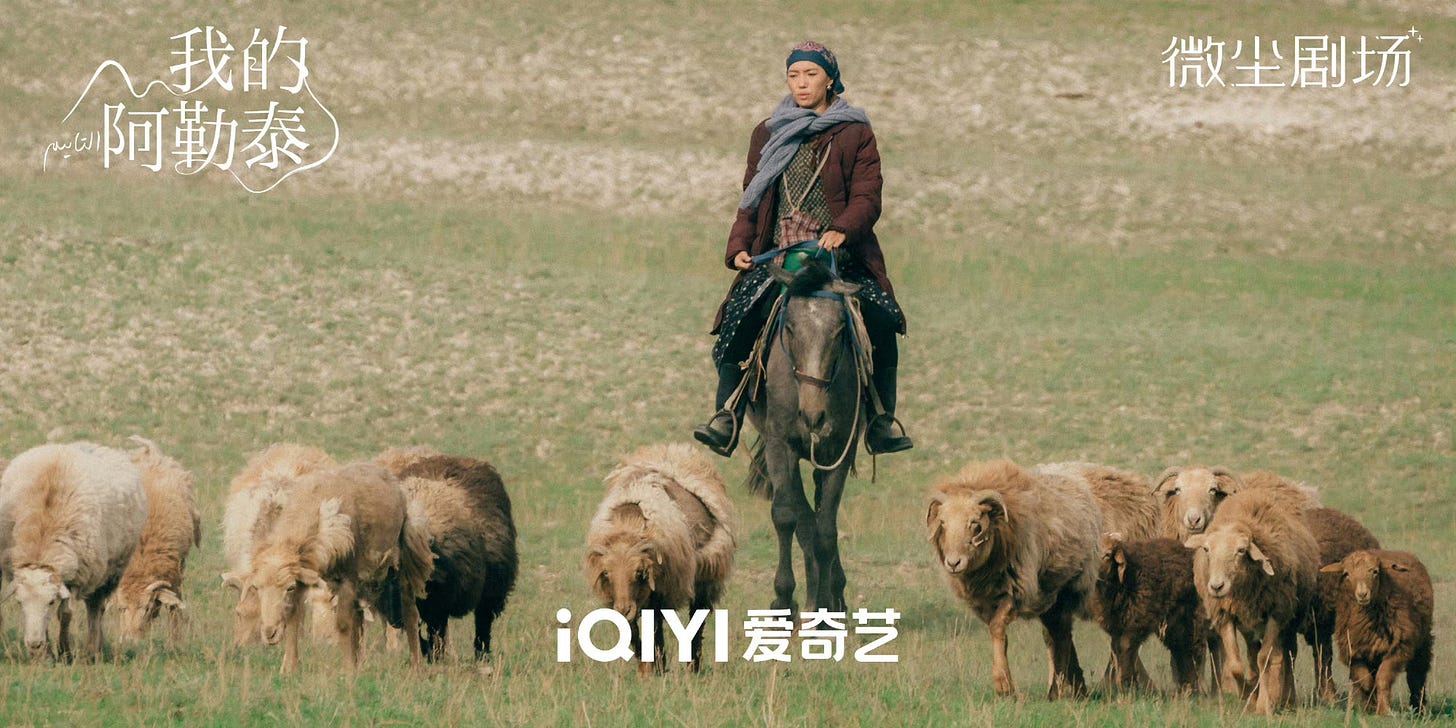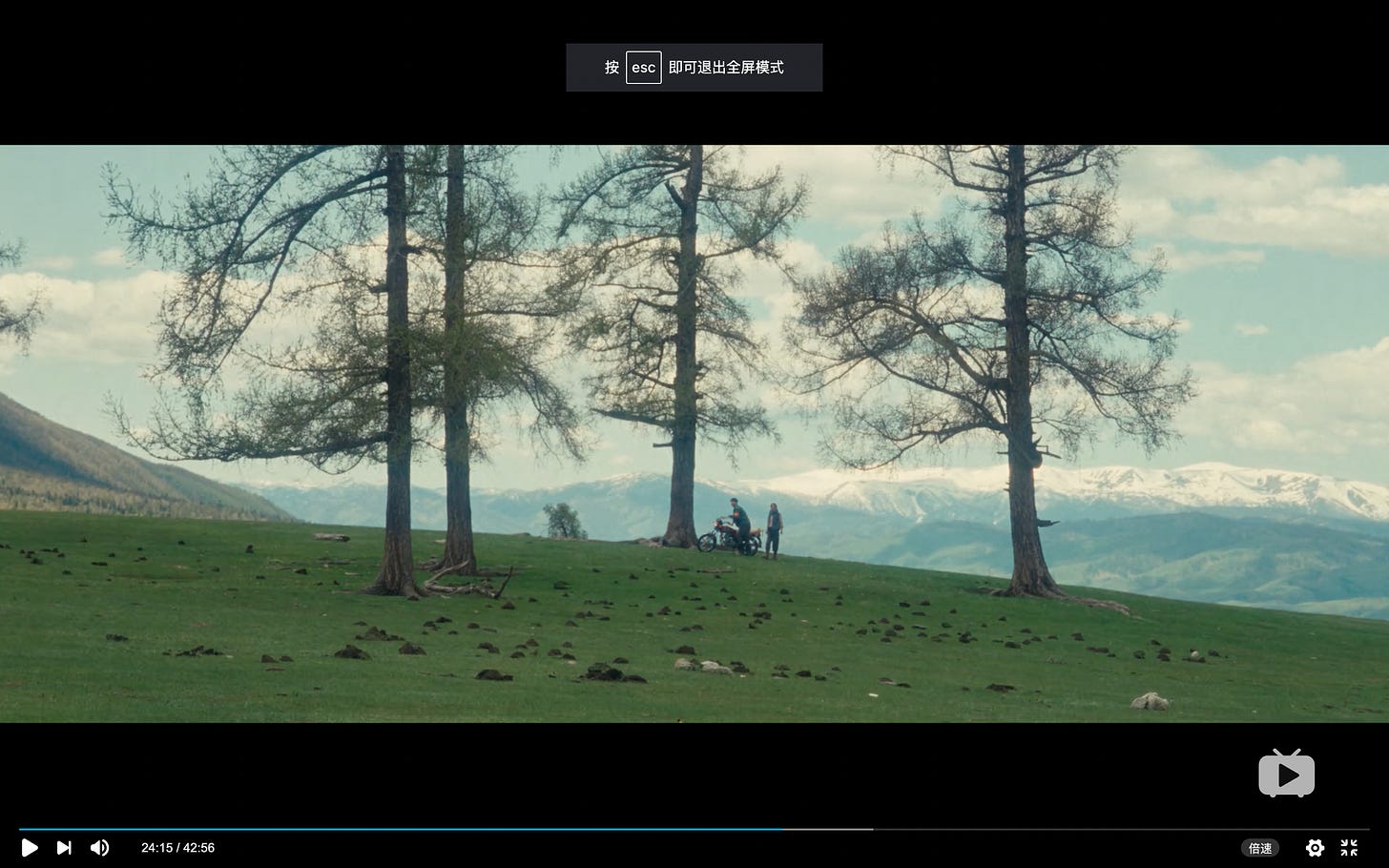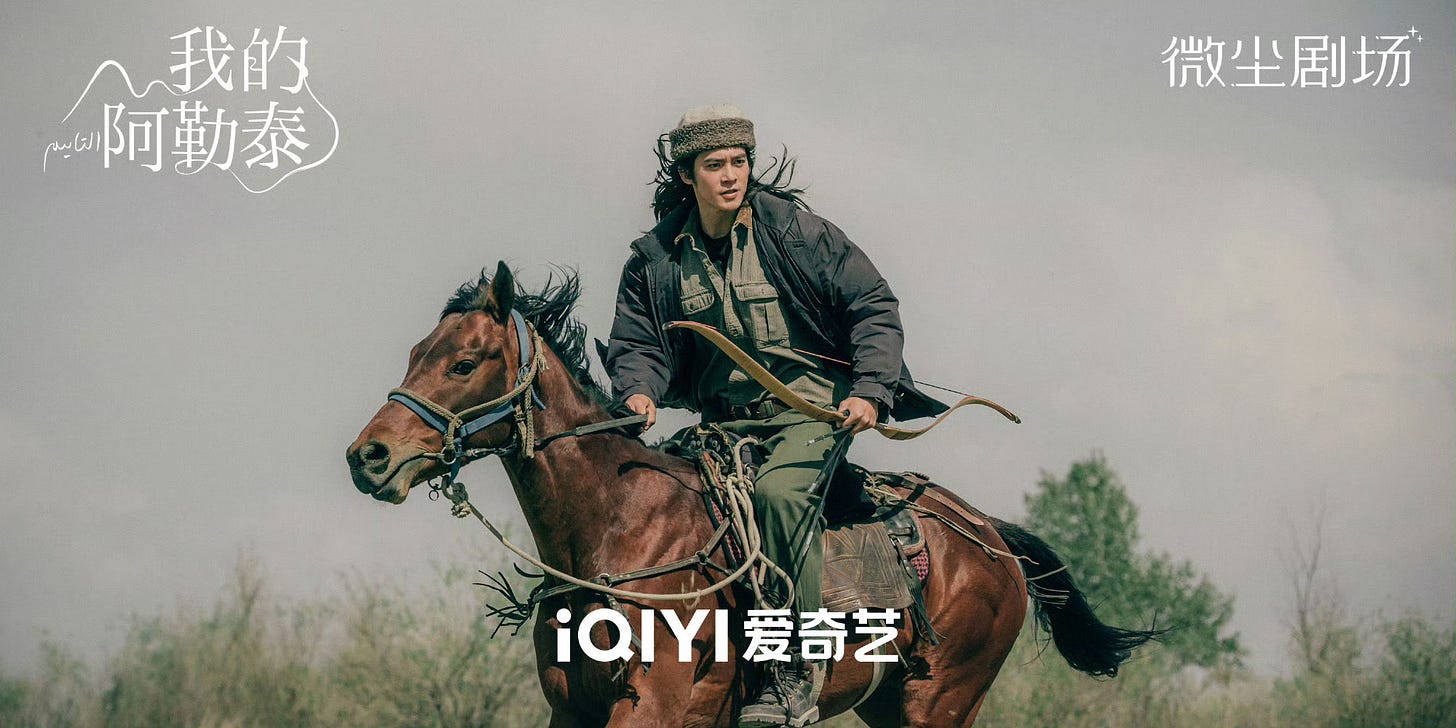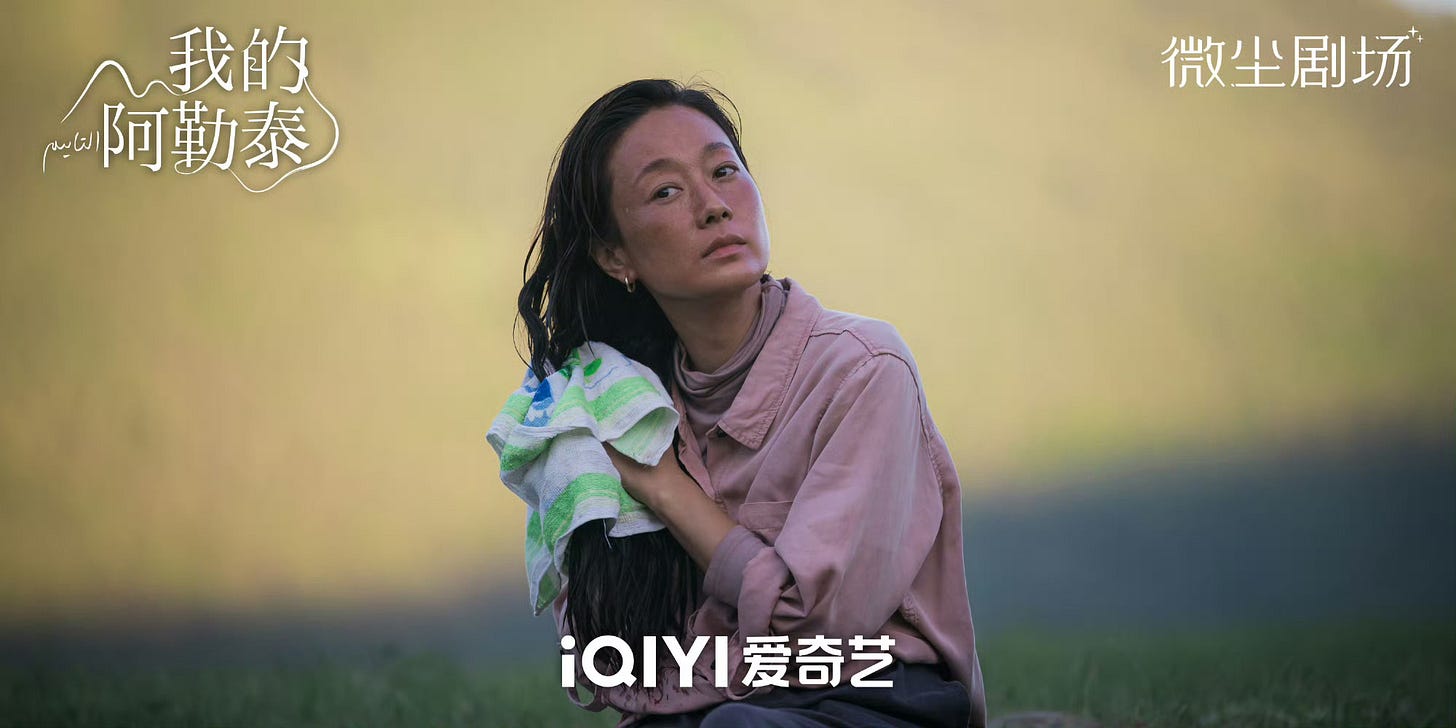09. Nomadland
The China Story, through a TV series about the Kazakhs in Xinjiang
Hi there. Welcome to Active Faults.
Yesterday in a desperate search for the focus of this issue I binged all 8 episodes of “我的阿勒泰” (To the Wonder), neiyu’s latest tour de force of a mini-series based entirely in Altay, Xinjiang UAR.
It’s been a hit on CCTV 1 the nation’s official broadcaster, with a solid 2.7% viewership count (source: China’s official big data centre for visual arts 中国视听大数据), all the while garnering success on iQiyi its streaming partner as one of the top 4 most hyped shows across the site. On Douban viewers gave it a whopping rating of 8.7/10, a shockingly high score for a mainland series and one of the highest in the past 5 years. It has even made the official selection of the Long Form Competition at the Cannes International Series Festival.
I began taking notes 10 minutes into watching it because it was essential to write about such a complex production. To the Wonder is the perfect example of how Chinese entertainment is currently handling racial, social, cultural and sexual tensions.
Let me tell you what I’ve seen.
The initial intrigue for me was how, oddly, the show aired simultaneously through TV broadcasters as well as streaming platforms. Normally it’s either/or, depending on the theme and target audiences. It was seemingly appealing to both the boomers looking for serious, conventional period dramas as well as younger viewers looking for a more light-hearted pastime.
As with the narrative, it is adapted from the author Li Juan’s 2010 essay collection “My Altay”, which documents her experiences in Northern Xinjiang living amongst the Kazakhs, a Turkic ethnic minority group native to the region.
Hence the intensifying alarm bells that rang in my head as I saw the opening credits: it is a “国家广电总局网络视听节目精品创作传播工程扶持项目” (what a mouthful) and a “北京市广电局重点资助项目”, meaning it has received funding from the National and the Beijing bureau of Broadcasting and Television. It’s backed, on multiple levels, by the top. Meanwhile, a brief search online will yield review op-eds published by Xinhua News and regional authorities like Altay News, a rare sight for a mini-series that isn’t explicitly political.
I thought, at this point, that it was going to be a suffocating watch of raging pro-party and pro-unity discourses. I couldn’t be more wrong. It’s a lot more bone-chilling than that because it is subtle as much as engaging.
The time is 2001, years before harassment, abuse, prosecution and surveillance of minorities in Xinjiang intensified. We trail behind the homecoming of a fledgling writer, Li Wenxiu after her life in the metropolis Urumqi goes bust. She feels deflated that she couldn’t make a living there, let alone Beijing, the shiny capital with opportunities and her ultimate ideal home. After getting bullied, scapegoated and fired as a waitress like Fontaine from Les Mis, she returns to where her mother resides in Altay to gather writing materials. She starts to live in an impoverished rural settlement called 彩虹布拉克 in the town of 富蕴, mainly populated by the Kazakhs. The audience's expectation is that she’d find inspiration and redemption in the stunning landscape and amicable, totally non-resentful minority natives, which she did.
But the main melody messaging stops here. To the Wonder is as much soft propaganda as it is soft resistance.
We’d later learn that the settlement is actually called 萨伊汗布拉克 meaning “Beautiful Spring” in Kazakh. The first half of the name was misconstrued by Li into the similar sounding Mandarin word “彩虹” based on its original Kazakh pronunciation. We encounter a recurring motif: language, identity and the sense of belonging, and how Mandarinisation poses a threat to it.
This is the first mainland series I’ve watched in the last decade, if not ever, that gave so much screen time to a regional dialect like Kazakh. At least 40-50% of the dialogues are spoken in Kazakh where you’d have to follow the subtitles. Neiyu’s freshest hotshot actor Yu Shi spent 6 months learning Kazakh before filming, to accurately portray the Kazakh male lead Batai. The rest of the dialogue is in heavily accented 疆普 (Xinjiang Mandarin), and all of the side characters sport various degrees of foreignness. Li’s mum Zhang Fengxia is from the Southeastern Yangtze region (the province of Jiangsu) but has acclimatised enough to have local inflections and tones. Li’s grandmother is from Shenyang, with a Dongbei accent. Zhang’s lover (her daughter’s former colleague) Liang is from the Cantonese-speaking coast.
Interestingly, the only person who spoke a jarringly unaccented, Received-Pronunciation equivalent of Mandarin was Li herself, despite being born in the province. She’s supposed to represent us the viewers who are most likely outsiders to the linguistic environment of Altay. We repeatedly see her experiencing miscommunications as she fails to penetrate the language barrier and understand the locals. Most of them did not cater to her needs by responding in Mandarin, about which she threw some tantrums. Equally, she has never shown the intention to learn the language properly and hold a sustained conversation with the villagers, relying on translators and interacting with Mandarin speakers instead.
I felt embarrassed watching Li petulantly blunder around and intrude into an ecosystem untainted by modernisation, industrialisation and neoliberalism, and perhaps that is the intended reaction. To the Wonder features scenes that interrogate centralised, Han-biased, diversity-blind monolithic governance on numerous societal aspects. We see locals marvelling at Li’s polyester jacket because they had never seen the fabric before, only for Zhang to dampen the excitement saying that it is but “plastic”. We hear Zhang telling Li that the Kazakhs are nomadic because they need to protect their land and give the soil time to replenish. We see how urbanisation does not prop up the underclass like Li, and Kazakh urban migrants struggling to fit into the built environment without a place to walk their horses.
We see how locals try to evade gun bans and anti-poaching laws that effectively force former hunters, like Batai’s father, into unemployment and poverty. We see Han scammers destroying habitats that the nomadic and pastoral Kazakhs depend on, digging up a cheaper breed of cordyceps (a rare fungus with medicinal uses) and reselling them as the expensive type. We see Batai and his father getting turned away at security checks in train stations, because they can’t carry their knives on board when the item is culturally significant. We see how bureaucracy, meritocracy, technocracy and market logic become trampled, as Li pathetically tries to instil those modern paradigms into the Kazakh society operating on a different model.
Where she sees villagers having outstanding tabs on the ledger of her mum’s convenience store, her mum sees a system based on trust, social affinity, non-monetary exchange of resources and sustainability. The same applies to local family dynamics when Zhang advises Li to stop interfering from the top down with how they manage interpersonal relationships and conflicts. Differences need to be respected and you cannot force an integration or assimilation, she said. These are incredibly subversive representations and sentiments that touch on a wide range of themes.
Another important cinematic device was the animals. Batai is a professional veterinarian and a horse breeder, descending from a long line of animal farmers raising sheep, horses and cows that graze on the grasslands. We learn that the Kazakhs traditionally revere horses as sacred, spiritual beings. In a pivotal scene where Batai and Li bond for the first time, he returns a horse skull to where it belongs hanging on the Horse Head Tree (马头树) of their village, a customary shrine for their beloved companions after they pass. A few days before, the skull had fallen onto Li which terrified her and prompted her to label it reminiscent of witchcraft. To that, Batai rebuts by explaining the tradition: not witchcraft, only “longing” and remembrance. If you know the less-than-tolerating political stances surrounding “sorcery”, superstitions, regional worship practices, faith and spirituality in China, you’d know the incendiary potential of this rebuttal.
A key narrative arc in the show is Batai’s profound relationship with a traumatised and injured rare breed horse, Taxue (‘snow treading’, left of frame in the picture above) as he nurses her back to health. As the plot thickens, the climax in the last episode shows Li (foolishly) provoking and confronting Liang the lover-turned-cordycep scammer. She escapes riding Taxue, but as Liang chases her on a motorcycle out of spite (metaphorically pitting modernity against nature, perhaps) Taxue panics and flings her off the back, fatally dragging her in the dirt. To save Li, Batai had to kill the senseless Taxue with a bow and an arrow before ending her misery with a knife. Watershed moment.
By the standards of a domestic series unrelated to warfare, To the Wonder aired more than a handful of shots of brutality, violence and blood. We see Batai’s anguished face splashed with the blood of his beloved Taxue, the whole shot tinted a crimson red to visually capture his oozing pain. He had to sever her head off to hang on the tree, and we see him walking away from the camera holding it like an Ancient Greek hero. Previously, we had seen him deliver a pony as well as his blood-soaked hands. In an era where words like “death” and “kill” are prohibited in a lot of entertainment content, depictions like this are hard to come by, especially when those “negative” imageries shown are intimately intertwined with affection and vitality. With birth, longing, tenderness and compassion.
The association of Batai with animals and blood doused his character in a specific light. It gave his gender and sexual persona a bearing unlike your routine neiyu male leads, consisting of “野生感” and ambivalence that I’ve written about before. The aura of a wild, untamed, authentic, dangerous yet endearingly naive cub of a man, toeing the edge of power and vulnerability. It doesn’t help that he was consistently styled in shoulder-length hair and a man bun, again unconventional and resistive for a neiyu drama. We the viewers cast a distinctly female gaze upon him during a game of 叼羊 or Buzkashi, a competitive sport commonly played in Central Asia, where the camera pans to show his muscles, tact, wavy locks and his glistening horse.
The characterisation of Batai as the subject of desire is the least insurgent part of the feminist debate that To the Wonder wants to stir up. The show revolves around a female-headed household and a tight, exclusively feminine intergenerational bond. Outside of this core relationship, we see a rally of powerful and unique women forming a psychological and physical alliance. It has enough conversations between women that could pass the Bechdel Test 5 times over.
It shows widowing, child-rearing, remarrying and slut-shaming, experiences that women resonate with and are often left unuttered. It unveils how women process patriarchal pressure, gender segregation, sexual desire, betrayal, abandonment, alcoholism, bereavement, old age, illnesses and dementia. It gave an outlet to feminine rage, pain, guilt and shame as well as their resistance. Our resistance.

Without prior knowledge, I became convinced that a man could never have shot the series after watching a shower scene (and I was right, the show has a female director Teng Congcong). Li, Zhang and the grandmother sit in a public bathhouse amongst other naked women of both Han and Kazakh descent. They scrub each other, caress each other and comb through each other’s hair while harmonising in a Kazakh song. Having grown up going to bathhouses with the women in my family and lost both of my grandmas in the last year, I burst into tears at that moment of transcendental connection, between them and between us. So much was reverberating in the acoustic of those steamy ceilings.
Compared to the unlikeable Li, her mother Zhang’s characterisation is so much more layered and magnetic. Her full name is 张凤侠, the last character “侠” meaning a type of traditional warrior folk hero character that’s integral to Chinese arts. She is often nicknamed “张大侠” (big vigilante) in the show by her daughter, with her fiery, tenacious and cavalier-like charms. She labours, bargains, haggles, snores and roams the village exuding confidence. She understands their rules of survival like a seasoned veteran. At night, she slouches on a weathered camping chair, drinking a bottle of the famed Wusu beer brewed with Xinjiang hops that my father often waxes poetry about when he misses living and working there in his twenties. Grieving her dead husband, she tries to rationalise solitude, denial and unmet needs that come with the gaping hole in her heart. It was unimaginably refreshing to see such a portrayal of complex feminine energy.
On a solo trip through the Gobi desert, she rescues the dying Liang from the road and ended up entering an ambiguous co-living relationship with him. As time goes on, it becomes clear that he’s a scheming bum too money-hungry to be satisfied living in the Kazakh way. He starts to churn out lines that remind you of a regular narcissist in the “real world”: I will make so much money through stone gambling, I will get you out of here into the city and start a business, your frail mother-in-law might need to be hospitalised so a move is necessary. At one point, Zhang confesses to him that all of a sudden she cannot understand Kazakh anymore. She is getting infected by Liang and the “white(Han)-supremacist capitalist patriarchy” he represents to the point that she has lost touch with her world.
The show ends with a Chinese New Year celebration. Although Li never really contributed meaningfully to the Kazakh world besides selling them some daily essentials, lecturing them occasionally and causing drama, it was her words and accounts that got to be published, in Mandarin of all languages. I’ll leave the rest of the epilogue for your viewing.
My point about the show is that contemporary propaganda has a smoother finish, and its magnitude is tenfold. I’m already seeing netizens stunned by the scenery and Altay Tourism Bureaus riding on the “traffic high tide” to boost local economies by upping their advertisements and accommodation qualities, while signposting attractions that are featured on the show. Certain tradeoffs are acceptable: you can be a little wayward as long as a bigger goal is achieved, that of glorifying an oppressed, contentious region and telling the China story well.
Should we be content that waywardness is permitted nonetheless, or concerned that something else is hijacking our consciousness? That we’re forgetting the tongue of resistance as we conform to the language of “stability” and unity?
















Thank you so much for this! I noped out after the first episode because it reminded me of how mainland india makes films about kashmir and the people there and that scene with batai's father at the station was super uncomfortable to watch. I've watched so many raving about the drama but the things they seem to have loved - the scenery, the "culture", the things they found funny... made me feel this wasn't for me. But it's good to know that there are threads of all these other things! Makes me want to give it another shot.
A great read, thank you! H/t to Bill Bishop for sharing this—and in the process alerting me to another account worth following.
"I thought, at this point, that it was going to be a suffocating watch of raging pro-party and pro-unity discourses. I couldn’t be more wrong. It’s a lot more bone-chilling than that because it is subtle as much as engaging."
As I read I confess to having these thoughts, too. Not unreasonably, I'd argue, given the prescribed narratives about "the miracle in China's west". So it was as encouraging as it was surprising to read this wonderful review of 我的阿勒泰, which I am now very keen to watch (in part because we spent two weeks in Zhaosu County on the Kazakh border in 2019).